

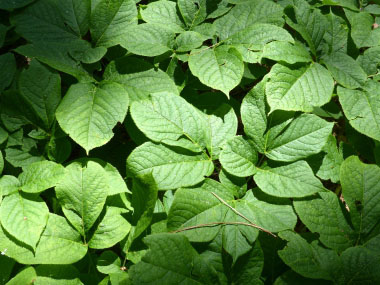
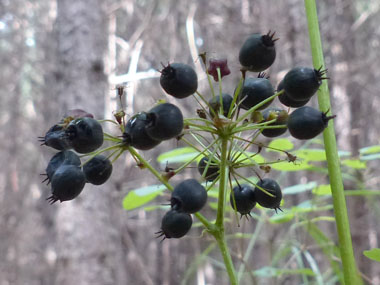

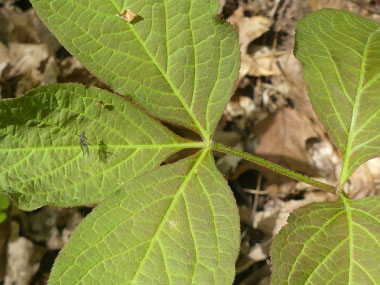
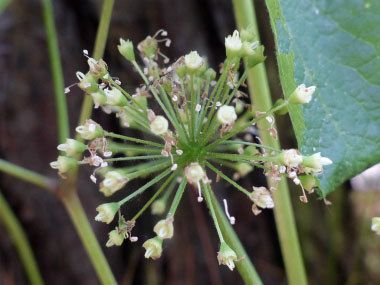
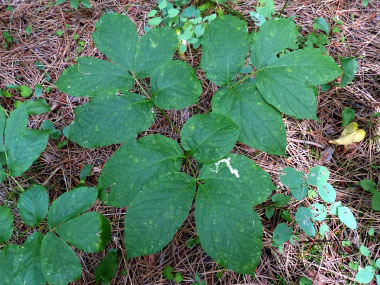
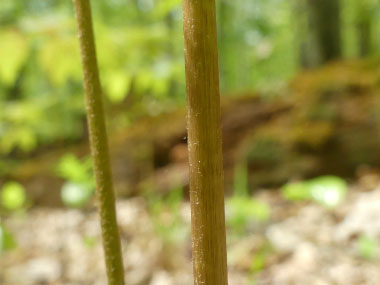
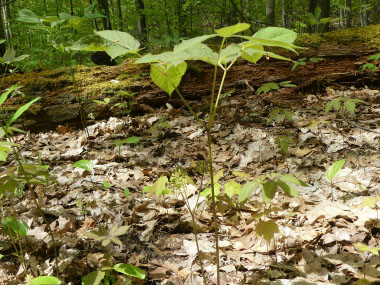
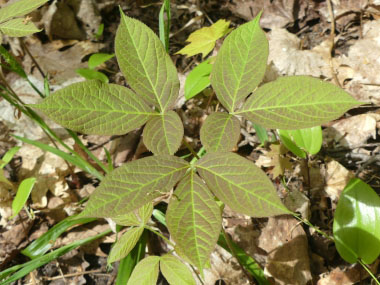
To support our efforts please browse our store (books with health benefits, etc.).
Wild sarsaparilla is a perennial plant that is a member of the ginseng family which also contains two other similar plants, the dwarf ginseng (Panax trifolius) and American ginseng (Panax quinquefolius). The common name refers to the former use of the plant's root as a substitute for sarsaparilla in making root beer. Although it shares some medicinal values with ginseng, it is not as potent. Traditional healers have used wild sarsaparilla to induce sweat, cleanse the blood, and to invigorate.
Distinguishing Features
The early leaves of wild sarsaparilla are often a shiny, bronze color that looks similar to early leaf growth of the poison ivy (Toxicodendron rydbergii). Once older, wild sarsaparilla leaflets become more rounded and are distinctly different. Anyone new to foraging must be very careful not to confuse the two plants! Wild sarsaparilla stems are erect and divides into a whorl of three stems which branch up and out, each forming 3 to 7 (most often 5) pinnately compound leaflets.
Flowers
Flowers are globular, greenish-white, and occur on top of a leafless, smooth stem. Rounded clusters are 3 to 5 cm wide; flowers have tiny petals. Depending on geographical location it flowers in late May or June. After blooming, purplish-black berries appear and grow in clusters.
 Fields
of Nutrition has medicinal benefits and vitamin/mineral content of Wild Sarsaparilla.
Fields
of Nutrition has medicinal benefits and vitamin/mineral content of Wild Sarsaparilla.
Leaves
Single, long-stalked; 20 to 40 cm tall; rising above the flowers; 3 branching parts each with 3 to 5 ovate leaflets; red-brown to red-green colour (younger leaves), changing to green during the summer. As the temperatures drop in the autumn, the leaves change to yellow or deep red.
Height
20 to 40 cm (8 to 15”) tall.
Habitat
This plant refers moist deciduous or mixed forests. Wild sarsaparilla prefers light sandy, medium loamy, and heavy clay soils. It can grow in nutritionally poor soil. The plant prefers acid, neutral, and basic soils. It can grow in full shade and semi-shaded areas. The range of this plant includes Alberta east to Newfoundland, south to Georgia, and northwest to Nebraska and North Dakota. There are also populations of this plant in the northwestern US and British Columbia.
Edible Parts
A nutritious food, it was often used by the First Nations people during times of battle or when they were hunting because it is sustaining. Young shoots can be cooked as a potherb. A refreshing herbal tea can be made from the root and it has a pleasant flavour. Fruit can be used to make a jelly and wine. In the 1800's, sarsaparilla was popular as a spring tonic.
Other Name
American Sarsaparilla.
Similar Plants
Ginseng.
Winter Survival Food Handbook

PDF Plant Magazines
Types of Wild Food
Geographic Zones Seasons
Disclaimer
EdibleWildFood.com is informational in nature. While we strive to be 100% accurate, it is solely up to the reader to ensure proper plant identification. Some wild plants are poisonous or can have serious adverse health effects.
We are not health professionals, medical doctors, nor are we nutritionists. It is up to the reader to verify nutritional information and health benefits with qualified professionals for all edible plants listed in this web site. Please click here for more information.
Why Edible Wild Food?
- Food costs are rising
- Free, wild food is readily abundant
- Wild food adds nutrition to your diet
- Wild food can help treat various medical conditions





